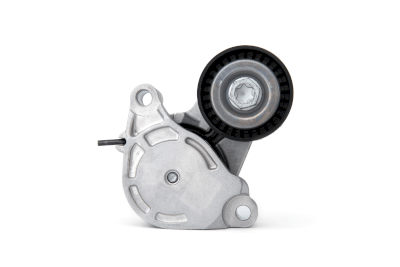What Is a Tensioner?

A tensioner is an adjustment device used to prevent slack in drive chains and belts.
Tensioners provide constant tension to the chain or belt, preventing it from falling off, damaging peripheral parts, or deteriorating transmission efficiency due to slack.
Tensioners are used in combination with sprockets and chain guides for chains, and with pulleys for belts, to prevent resistance to rotation. They are broadly classified into two types: those that adjust the tension on a case-by-case basis and those that automatically adjust the tension to an appropriate level.
Uses of Tensioners
Tensioners are mainly used to adjust the tension of automobile fan belts, air conditioner belts, and timing chains.
Since fan and air conditioner belts are made of rubber, they stretch during use. If left unchecked, this can result in high-frequency noise due to belt slippage, inadequate alternator power generation due to deteriorated transmission efficiency, and insufficient cooling of the air conditioner. Providing tension with a tensioner can solve these problems.
Also, by limiting the range of motion of the tensioner, it is possible to determine the limit of belt/chain elongation when slack occurs, even after adjusting the tensioner to its maximum value.
Principles of Tensioners
There are two main types of belt tensioners: manual and automatic, which use hydraulic pressure or spring tension.
In the case of manual tensioners, the pulleys and gears are adjusted up or down with bolts and nuts to set the belt to the desired tension, offering the advantage of being less expensive than automatic tensioners.
In the case of automatic tensioners, the tension is continuously adjusted to an appropriate level by hydraulic pressure or spring tension. This saves maintenance time and is particularly useful for parts like timing chains that are not exposed and difficult to adjust manually.
Additionally, tensioners that incorporate a hydraulic anti-return mechanism minimize tension fluctuations caused by hydraulic pulsations.
Manual adjustment of tensioners requires careful attention to avoid noise from insufficient tension or belt breakage due to over-tensioning. In contrast, auto tensioners avoid these issues, though they are more expensive. When replacing a tensioner, often other parts like chain guides and pulleys must also be replaced. If a tensioner with an anti-return mechanism is removed during belt or chain replacement, it cannot be reused as it is stretched to the limit and will not return.